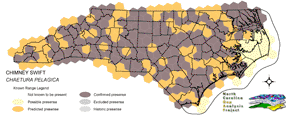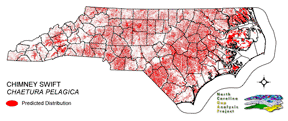
| Taxa: |
| Order: |
| Family: |
| Aves |
| Apodiformes |
| Apodidae |
| NatureServe Global Rank: |
| NatureServe State (NC) Rank: |
| G5 |
| S5B,SZN |
| Federal Status: |
| NC State Status: |
| --- |
| --- |


| Land Unit |
| US Fish & Wildlife Service |
| US Forest Service |
| US National Park Service |
| US Department of Defense |
| NC State Parks |
| NC University System |
| NC Wildlife Res. Com. |
| NC Forest Service |
| NC Div. of Coastal Mgmt. |
| Local Governments |
| Non-Governmental Org. |
| Other Public Lands |
| Private Lands |
| GAP Status 1-2 |
| All Protected Lands |
| Statewide |
| Hectares |
| 7,272.36 |
| 12,970.08 |
| 16,013.70 |
| 9,477.00 |
| 2,165.04 |
| 1,216.62 |
| 4,962.87 |
| 976.65 |
| 571.68 |
| 670.50 |
| 1,714.50 |
| 2,462.85 |
| 3,939,103.62 |
| 20,777.19 |
| 59,101.53 |
| 3,999,577.47 |
| Acres |
| 17,970.39 |
| 32,049.76 |
| 39,570.71 |
| 23,418.17 |
| 5,349.93 |
| 3,006.33 |
| 12,263.52 |
| 2,689.87 |
| 1,412.65 |
| 1,656.84 |
| 4,236.62 |
| 6,085.83 |
| 9,733,735.13 |
| 51,618.06 |
| 146,319.54 |
| 9,883,445.75 |
| % of Dist. on |
| Prot. Lands |
| 12.3 % |
| 21.9 % |
| 26.9 % |
| 16.0 % |
| 3.7 % |
| 2.1 % |
| 7.5 % |
| 1.7 % |
| 1.0 % |
| 2.7 % |
| 2.7 % |
| 3.1 % |
| < 0.1 % |
| 35.2 % |
| ----- |
| ----- |
| % of Dist. on |
| All Lands |
| 0.2 % |
| 0.3 % |
| 0.4 % |
| 0.2 % |
| < 0.1 % |
| < 0.1 % |
| 0.1 % |
| < 0.1 % |
| < 0.1 % |
| < 0.1 % |
| < 0.1 % |
| < 0.1 % |
| 98.5 % |
| 0.5 % |
| ----- |
| ----- |
|
Fairly common to abundant across the state (Potter et al. 1980). Spends most of the day high in the air foraging for flying insects over any type of habitat (Kaufman 1996), but is most abundant in residential areas. Roosts and nests in primarily in chimneys, but will also use the inside walls of vacant buildings, old cisterns, and wells (Nicholson 1997). Rarely uses ancestral habitat of caves, sinkholes, and hollow trees due to the lack of a sufficient number large enough for nesting (Kaufman 1996). Nests in small colonies, with helpers at most nests (Ehrlich et al. 1988). Nest is located on the vertical wall of the chimney, at least 2 m from the opening (Nicholson 1997). NATURE SERVE GLOBAL HABITAT COMMENTS: Aerial; flies over open habitats and woodland, especially around human habitation (cities, towns, farms). Flies all day, roosts in air shafts and chimneys. REPRODUCTIVE HABITAT COMMENTS: Nests primarily in chimneys, air shafts, silos, and similar sites (vertical surface within shaft), formerly on cliffs and in hollow trees. |
| Code | Name | Description | NC Natural Heritage Program Equivalent |
| 124 | Maritime Scrubs and Tidal Shrublands | Coastal shrubs including wax-myrtle, swamp rose, alder, yaupon, and greenbriar. | Maritime Shrubs, Salt Shrub |
| 372 | Interdune Herbaceous Wetlands | Dune swales with permanently flooded to intermittently exposed hydrology. Species composition depends on salinity and can include cut grass, spike-rush, mosquito fern, and hornwort. | Interdune Pond, Maritime Wet Grasslands |
| 371 | Maritime Grasslands | Dune grass community consisting of sea oats and beach grasses. | Dune grass, Maritime dry grassland |
| 180 | Agricultural Crop Fields | Farm fields used for row crops. | No equivalent |
| 205 | Agricultural Pasture/Hay and Natural Herbaceous | Farm fields used for pasture grass or hay production, as well as old fields dominated by native and exotic grasses. | No equivalent |
| 202 | Residential Urban | Includes vegetation interspersed in residential areas. Includes lawns, mixed species woodlots, and horticultural shrubs. Vegetation accounts for between 20 - 70% of the cover. | No equivalent |
| 203 | Urban Low-Intensity Developed | Highly developed areas with vegetation accounting for < 20% of the cover. | No equivalent |
| 204 | Urban High-Intensity Developed and Transportation Corridors | Highly developed areas including infrastructure such as roads, railroads. Vegetation represents < 20% of the cover. | No equivalent |
| 535 | Talus/Outcrops/Cliffs | Includes seep talus slopes with sparce vegetation, as well as outcrops including, granitic outcrops. Some outcrops will have been mapped as barren rock. | No equivalent |
|
Carter, M., G. Fenwick, C. Hunter, D. Pashley, D. Petit, J. Price, and J. Trapp. 1996. Watchlist 1996:For the future. Field Notes 50(3):238-240.
Bent, A. C. 1940. Life histories of North American cuckoos, goatsuckers, hummingbirds, and their allies. Part I. U.S. Nat. Mus. Bull. 176. 244 pp., 36 pls. Kaufman K. 1996. Lives of North American Birds. Boston, New York: Houghton Mifflin Company. Nicholson CP. 1997. Atlas of the breeding birds of Tennessee. Knoxville: University of Tennessee Press. Fisher, R.B. 1958. The breeding biology of the chimney swift. 141 pp. Harrison, C. 1978. A field guide to the nests, eggs and nestlings of North American birds. Collins, Cleveland, Ohio. Harrison, H.H. 1979. A field guide to western birds' nests. Houghton Mifflin Company, Boston. 279 pp. Potter, E. F., J. F. Parnell, and R. P. Teulings. 1980. Birds of the Carolinas. Univ. North Carolina Press, Chapel Hill. 408 pp. Terres, J.K. 1980. The Audubon Society encyclopedia of North American birds. Alfred A. Knopf, New York. Whittemore, M. 1981. Chimney swifts and their relatives. Nature Books. 176 pp. American Ornithologists' Union (AOU), Committee on Classification and Nomenclature. 1983. Check-list of North American Birds. Sixth Edition. American Ornithologists' Union, Allen Press, Inc., Lawrence, Kansas. Ehrlich, P.R., D.S. Dobkin, and D. Wheye. 1988. The birder's handbook:a field guide to the natural history of North American birds. Simon and Shuster, Inc., New York. xxx + 785 pp. Stiles, F.G., and A.F. Skutch. 1989. A guide to the birds of Costa Rica. Comstock Publ. Associates, Cornell University Press, Ithaca, New York. 511 pp. |
For more information please contact them at:
NC-GAP Analysis Project
Dept. of Zoology, NCSU
Campus Box 7617
Raleigh, NC 27695-7617
(919) 513-2853
www.basic.ncsu.edu/ncgap